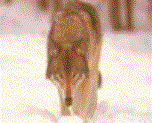LITR 4332: American Minority
Literature

Student Poetry Presentation 2004
Reader:
Robert Hodson
Respondent:
Janice Strasser-King
"The
Last Wolf"
By:
Mary Tallmountain

Unsettling
America pg. 33-34
Bibliographical
information:
Mary
TallMountain was a Native Alaskan writer and elder who lived for many years in
San Francisco's Tenderloin district. She is remembered for her generous
encouragement of aspiring writers of all ages, from inner-city San Francisco to
remote villages in Alaska where she taught poetry to children in her later
years. She was born in 1918 in
Nulato, a village along the Yukon River in Alaska, to a Koyukon/Athabaskan
mother and a Scots/Irish father. When her mother became terminally ill, Mary was
adopted by a non-Native couple and taken away from her village. Traumatized
first by losing her family and homeland, then by the harshness of mainstream
American culture, she felt like an angry outsider for many years. Writing was a
way of going home, of reclaiming her ancestry, her family and her homeland, and
a way of claiming her own proud native voice. She passed away in 1997 at the age
of 79. http://www.freedomvoices.org/mary.htm
Objectives:
1a.
Forced particpation- Indians had no
choice and were forced to live under the conditions of the newcomers
3b.
"Loss and Survival"
(Whereas
immigrants define themselves by leaving the past behind in order to become
American, the Indians were once “the
Americans” but lost most of their land along with many of their people. Yet
Native Americans defy the myth of "the vanishing Indian," choosing to
"survive," sometimes in faith that the dominant culture will
eventually destroy itself, and the forests and buffalo will return.)
5c. To
regard literacy as the primary code of modern existence and a key path to
empowerment.
Literary
Terms:
Tone- The
Bedford Glossary of Critical and Literary Terms defines this term as “the
attitude of the author toward the reader or the subject matter of a literary
work” (482). Mary Tallmountain's
tone is a tone of humbleness and helplessness but also has a tone of distress.
Imagery-
Imagery
is language that evokes one or all of the five senses: seeing, hearing, tasting,
smelling, touching. Mary
Tallmountain uses vivid and descriptful words that give the reader a mental
picture of what she is writing.
-Poem
Reading- "The Last Wolf"

Interpretation
of poem:
Put
simply this poem is about how the Indian's land was taken from them and then
turned into something that the Indians did not want. Land that was once frontier is now a metropolitan-like city
that was bulit by the new-comers to America.
Being forced to live in the city is sadly described by Mary Tallmountain.
There is an underlying theme in the poem that hints blame on the newcomer for
doing what he has done. A sense of
change back to a natural state is implied through the use of negativley
descriptive words about the city.
Discussion
Questions:
1.
Does the mention of east and west have any importance in this poem?
If so, what?
3.
What is so symbolic about the wolf in this poem?
2.
What is meant by the Wolf's blue eyes burning yellow?
4.
In this poem who are they and what exactly have they
done?